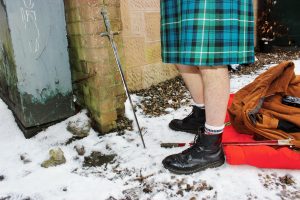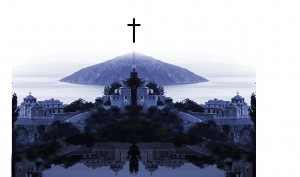Why I Wear Clown Makeup to Prep School
by Maya Love Shkolnik | March 10, 2024
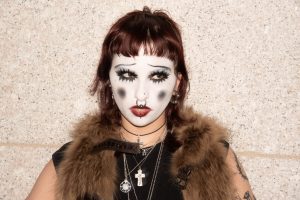 Val and I met on Tinder in January of 2021. I was at my lowest then—I mean, I was on Tinder in Massachusetts, home of MIT and Harvard students (shudder), crazed Patriots fans, and the Pilgrims. The city is still pretty puritan: no drinking till 21! Gasp! We value modesty, “neighborly concern,” and professional excellence. In a place like this, queerness—something meant to be free from the expectations of society—is celebrated only when it is comfortable, familiar, and adherent.
Val and I met on Tinder in January of 2021. I was at my lowest then—I mean, I was on Tinder in Massachusetts, home of MIT and Harvard students (shudder), crazed Patriots fans, and the Pilgrims. The city is still pretty puritan: no drinking till 21! Gasp! We value modesty, “neighborly concern,” and professional excellence. In a place like this, queerness—something meant to be free from the expectations of society—is celebrated only when it is comfortable, familiar, and adherent.
Meeting Val was like a breath of fresh air. We bonded over our experiences of the not-so-subtle ostracization which came with growing up as queer students in boarding schools. Val, at age 17, had to speak about being transgender in front of over one thousand students and teachers. She was made to feel different from the other students—made to perform for them, to speak from a podium on stage.
Hilariously smart and beautiful, Val is a film student who loves experimenting with clown makeup. Clown makeup, erring on the side of drag, appears campy and bold. She is empowered by this: “You would think that putting on a face of white foundation, reshaping my eyebrows, and painting new lips would remove me from myself. But with clown makeup, I’m uniquely able to access my whole self.”
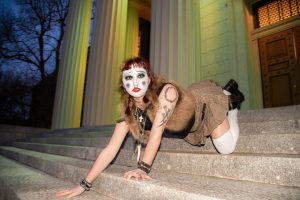
Years later, with Val’s story still in mind, I wanted to properly introduce Val’s clown makeup to the academic institution itself. We chose Phillips Academy Andover and its self-important architecture as the backdrop. Her presence there challenges the affected, blanket acceptance of “Youth from Every Quarter” (the school’s real motto). If the school could talk back, what would it say? We got a partial answer to that question when, to our surprise, students were returning from the winter holiday that evening. We sensed varied stares: some judgmental, some too ashamed to look, and all curious.
Woven into the very fabric of America (Andover was founded two years after America), these schools are responsible for nurturing generations of productive intellectuals. They contribute to society by producing people who are economically and socially marketable. Obviously, queer students are high achieving (mostly joking), but they quickly learn, by watching their straight peers who “don’t cause issues,” that they can only reveal a part of themselves in certain academic or professional rooms. As times change, certain gay identities have become more accepted in society, which comes with more rules, more hiding, more social markers, more lying. Fewer problems that way—so it seems. For queer students, performing identity becomes a regular part of everyday life.
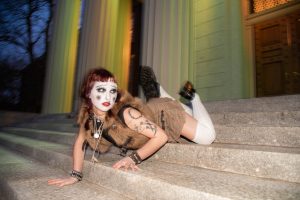
The aim of our photoshoot: interfere with the serious reality of schools in Massachusetts. Val, climbing down the stairs of iconic Samuel Phillips Hall, the history building appearing in every image when you look up the school. I think it’s important to play games with history a bit. Val told me: “I feel more confident with people staring at me, in the dining hall or on the train. It’s not a shield at all, but a way to express part of my personality I don’t get to show as often. With it, I feel unstoppable and beautiful.”
Stifling queerness is robbing the world of creativity. A palatable gay person—a depressing cliché—reduces queerness to a stereotype while simultaneously entirely defining that person as ‘the gay one’. There is no correct way to be queer; why would anyone want that? No one should feel like they are existing in the wrong way. I think Val can teach us to find ways of experiencing our full selves—and doesn’t she look beautiful? ∎
Words and Photography by Maya Love Shkolnik.
